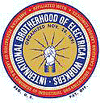Hi Ben,
I think I might be able to help, but just need to stitch up some of your terminology which is a bit different to some of ours here in Australia. Electricity is electricity no matter what part of the world you're in....it's just how we say it that changes.
Could be a long discussion for the boards....email me at ericsgrandpa@hotmail.com.
Cheers, DU
Results 1 to 10 of 42
Thread: 3 Phase rotation?
-
03-13-2007, 10:15 PM #1
 3 Phase rotation?
Featured Sponsor
3 Phase rotation?
Featured SponsorHow do you check 3 phase rotation? And would you ever rotate a bank counter clockwise? The reason I ask is that at my old utility [Iíve only worked for two] I was taught to always rotate a bank clockwise. Red, white and blue. Blue being the high leg. I was taught this from day one as an apprentice. Swap red or white until I got clockwise rotation. Here I will swap the white and blue. On a Y Y bank I just rotate it clockwise, land the colors where they fall. Now Iím finding 3 phase pad mounts at my new utility rotated counter clockwise [not all but some] red being the high leg here. The lineman before me took a permanent marker and wrote counter clockwise on the inside door with the colors. Just would like hear what others are doing out there.
-
03-13-2007, 10:39 PM #2Downunder Guest
 Maybe I can help
Maybe I can help
-
03-13-2007, 10:40 PM #3

Correct me if I'm wrong but the industry standard is red for the high leg and look for a clockwise rotation and mark accordingly.On a yy I start from the left with red find clockwise and mark it.Be safe.
-
03-13-2007, 10:48 PM #4
 Sorry Downunder?
Sorry Downunder?
As a lineman before I replace a transformer or service etc, I will check rotation before I d-energize so when I finish it has the same rotation so as not to screw up the customers motors.
Last edited by PA BEN; 03-13-2007 at 10:50 PM.
-
03-13-2007, 11:26 PM #5
 Senior Member
Senior Member
- Join Date
- May 2006
- Location
- ohio
- Posts
- 253

pa ben,perhaps you are seeing the inside electricins work,,,,your s should be clockwise,,,,,he must match up to you ..in the old days lineman accomodated this ,,but today we are liable ,,,scammy
-
03-13-2007, 11:36 PM #6

 Things depend on which end of the wire you are on. The NEC, which governs inside wiring, the normal color code for 120/208 wye is black, red, blue. For 277/480 wye it is brown, orange, yellow. For 120/240 delta, it is black, orange, blue; with the wild leg being orange. 240/480 delta would be brown, orange, yellow again; the wild leg being orange. The NEC states that the wild leg SHALL be coded orange. Panels are always wired ABC, clockwise rotation. White SHALL only be used for grounded, current carrying conductors, ie. system neutral.
Things depend on which end of the wire you are on. The NEC, which governs inside wiring, the normal color code for 120/208 wye is black, red, blue. For 277/480 wye it is brown, orange, yellow. For 120/240 delta, it is black, orange, blue; with the wild leg being orange. 240/480 delta would be brown, orange, yellow again; the wild leg being orange. The NEC states that the wild leg SHALL be coded orange. Panels are always wired ABC, clockwise rotation. White SHALL only be used for grounded, current carrying conductors, ie. system neutral.
Once you hit the utility side, there's a lot of difference of opinion and color coding. Most utilities I've run across go with red, white, blue orientation left to right in a padmount or on a cluster mount transformer bank. When it gets to the customer end, whatever the rotation is at the service connection that gives the customer what they need is how it's labeled, generally either ABC or CBA. The high leg is predominantly marked white, and is labeled as B phase.
As far as primary goes, the labeling A, B, C starts from the station transformer, and is marked on system maps. Underground cabling is typically marked red, white, blue; A, B, C, respectively.
As far as rotation meters go, they don't care what color is with which phase, as long as the voltage rotation is in the proper order. This meaning that if you get a clockwise rotation with red as A, white as B, blue as C, you will still get the same rotation if you hook red up to B, white to C, and blue to A, or red to C, white to A, blue to B. Once you transpose just two leads, then you will get an opposite rotation.
On new electrical installations with three phase motor loads, an electrician can hook up all the motors to the panels before having power available, and have them all connected for a clockwise rotation because there are test instruments out there that you can hook up to motor leads, give the shaft a spin in the direction it is supposed to turn, and the instrument will give a rotation indication on the leads. Something that comes in very handy on large well pump motors to keep from spinning the shaft sections apart the first time power is applied! Also, better industrial electrical installations will have phase loss/reversal relays that will prevent equipment from starting if a phase is missing or if the rotation somehow got reversed, such as from a transformer changeout. Relays are inexpensive, some of them cost less than $50. Living my life and loving it!!!
Living my life and loving it!!!
-
03-14-2007, 09:57 AM #7
 Senior Member
Senior Member
- Join Date
- Jul 2003
- Location
- Virginia, USA
- Posts
- 549
 a little extra confusion
a little extra confusion
We have a few OLD services where the meter base is counterclockwise however the service inside the building is clockwise because the electrician has swapped middle and right between the CT cabinent and the panel box. This was especially common on 120/240 open delta (where they would move the high leg). If we hookup a new service we go clockwise. For the already existing we match what was there. Just one more thing to check. By the way, we don't mark any leads with white anymore we have substituted yellow.
-
03-14-2007, 02:01 PM #8
 Senior Member
Senior Member
- Join Date
- Feb 2005
- Posts
- 171
 This is the thing!
This is the thing!
Your probably starting to see that things are done differently everywhere you go. When in Rome!
Rotation only matters when the customer(s) are already existing on the three phase bank or line. You cannot change them at that point. You must put them back in the same rotation as they were prior to any work you have performed. That will burn up motors.
They do have new technology that will prevent the customer from being put back into service when it senses the rotation is incorrect. The customer must purchase this, and it is NOT on all customer equipment. Probably very few but it's out there.
On new customer hookups it does not matter. They must hook up to what the Utility provides to them. Although there is a unwritten policy that clockwise should be the preferred hook up, it is NOT the rule by any means.
As for how to take rotation, you should know how to use a rotation meter by now. Try to always use the same color for the high leg if there is one in your bank. I use blue or "c phase" for my 208 on a 120/240/208 Wye-Delta. Then watch the motor spin and make sure you have all three lights light up signifying that all 3 phases connected to the clips are energized. It will spin with only 2 of the 3 phases energized. Very slowly.
Remember when changing 2 secondary leads to change rotation on a Wye-Delta Bank, never swop using the high leg. Wye-Wye Banks do not have a high leg and it will not matter which 2 legs you can change.
Tape consistantly. Always mark before cutting. Always write down everything you could possibly think of on a note pad. Write it on the padmounted transformer door.
Take rotation at the customers panel, not just at the bank. Just another method of double checking everything. You write it all down on that note pad. Every apprentice MUST carry one. Every Journeyman should too.
When in doubt- ASK! Keep asking until you understand. Don't be that monkey that always shakes his head. It is important to know and understand everything about what you are doing. Ask Questions all the time. The only dumb question is the one you don't ask.
-
03-14-2007, 04:02 PM #9

Well said, 500. Although if you were to hook up a new industrial customer with a bunch of 3 phase motor loads, and they had already hooked up their end while the utility engineer was deciding which way he wanted the printing facing on the underground PVC conduit, I think they would have issues with you if you told them they will have whatever rotation you decide to give them. Once things hit the customer's main disconnect, everything is consistently color coded, and rotation and phasing orientation is maintained throughout their system. It is much easier to swap a few connections at the transformer than to rewire dozens or hundreds of motors, and the customer has the expectation that they will have clockwise rotation at their mains, along with the voltages they requested from the utility.
Thrasher, it's good to hear you are getting away from marking phases with white tape! Helps end some of the confusion when the customer has white markings on their end, and you can't put a white phase with it! Two other special color codes for the NEC are, of course, green for ground conductors, and grey is used to mark neutral conductors, generally on 277/480 systems.Living my life and loving it!!!
-
03-14-2007, 06:12 PM #10
 Senior Member
Senior Member
- Join Date
- Feb 2005
- Posts
- 171
 That's just it
Featured Sponsorr
That's just it
Featured SponsorrThe couple of Utilities I have worked for make the rules. New customers will get what we give them. It is their responsibility to make their rotation what they need it to be. Everything has already been engineered and approved before they get the okay to begin work. Our rules are very specific and have been around for a long time. Contracors know the drill here.
Yes it could be easier for us to change the connections in some instances, but If you have staggered buswork in a pad mounted transformer it isn't so easy. You then get into changing primary phases. Then you have a cable with c imprinted into the jacket on a B Module.
the company will not spend the time and money to fix something when our rule is spelled out loud and clear to the contractor wiring a building.
We sometimes can have 10 runs of 500 Copper on each phase. We aren't going to sleeve out all that and move it. I think changing primary phases around for that to be foolish too.
Our rule is that they need to change their equipment if the rotation is wrong. We will not do it. We are just too busy and have problems keeping up with our normal scheduled work. We aren't going to worry about a contractor who did not follow our rule.



 Reply With Quote
Reply With Quote

